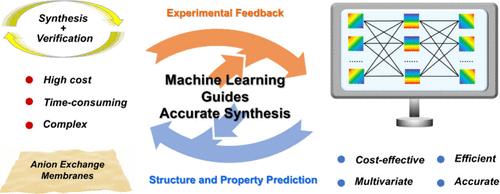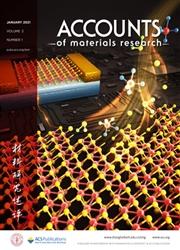Machine Learning for Prediction and Synthesis of Anion Exchange Membranes
IF 14
Q1 CHEMISTRY, MULTIDISCIPLINARY
引用次数: 0
Abstract
Anion exchange membrane fuel cells (AEMFCs) and water electrolyzers (AEMWEs) play a crucial role in the utilization and production of hydrogen energy, offering significant potential for widespread application due to their high energy conversion efficiency and cost-effectiveness. Anion exchange membranes (AEMs) serve the dual purpose of gas isolation and the conduction of OH– ions. However, the poor chemical stability, low ionic conductivity, and inadequate dimensional stability of AEMs hinder the development of AEM-based energy devices. AEMs exhibit a more intricate chemical structure than general polymers, primarily due to their complex composition and unique attributes. This complexity is attributed to varying chain lengths, degrees of branching, and copolymerization compositions. Furthermore, diverse ion types, ion distribution, ion exchange capacity, hydrophilic clusters, electrostatic interactions, and microphase morphology further complicate these characteristics. In the past decade, more than 5,000 references have been dedicated to obtaining high-performance AEMs. Despite the large amount of work conducted during this period, the performance of AEMs still falls short of meeting the actual needs. The trial-and-error method used in designing membrane structures has proven inefficient and costly. Machine learning, a data-driven computational method, leverages existing data and algorithms to predict yet-to-be-discovered properties of materials. Recently, our group and some researchers have utilized machine learning to expedite the process of material discovery and achieve accurate synthesis of high-performance AEMs.

阴离子交换膜预测与合成的机器学习
阴离子交换膜燃料电池(aemfc)和水电解槽(AEMWEs)在氢能源的利用和生产中起着至关重要的作用,由于它们具有较高的能量转换效率和成本效益,具有巨大的广泛应用潜力。阴离子交换膜(AEMs)具有气体隔离和OH -离子传导的双重作用。然而,aem的化学稳定性差、离子电导率低、尺寸稳定性不足等问题阻碍了aem能源器件的发展。AEMs表现出比一般聚合物更复杂的化学结构,主要是由于其复杂的组成和独特的属性。这种复杂性归因于不同的链长度、分支程度和共聚组成。此外,不同的离子类型、离子分布、离子交换容量、亲水性团簇、静电相互作用和微相形态进一步使这些特征复杂化。在过去的十年中,有超过5000篇文献致力于获得高性能的AEMs。尽管在此期间进行了大量的工作,但AEMs的表现仍然不能满足实际需求。在设计膜结构时使用的试错法已被证明是低效且昂贵的。机器学习是一种数据驱动的计算方法,它利用现有的数据和算法来预测尚未发现的材料属性。最近,我们小组和一些研究人员利用机器学习加快了材料发现的过程,并实现了高性能AEMs的精确合成。
本文章由计算机程序翻译,如有差异,请以英文原文为准。
求助全文
约1分钟内获得全文
求助全文

 求助内容:
求助内容: 应助结果提醒方式:
应助结果提醒方式:


